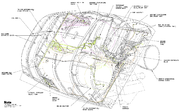
Space Shuttle Orbital Maneuvering System
Encyclopedia

Rocket
A rocket is a missile, spacecraft, aircraft or other vehicle which obtains thrust from a rocket engine. In all rockets, the exhaust is formed entirely from propellants carried within the rocket before use. Rocket engines work by action and reaction...
engines designed and manufactured by Aerojet
Aerojet
Aerojet is an American rocket and missile propulsion manufacturer based primarily in Rancho Cordova, California with divisions in Redmond, Washington, Orange, Gainesville and Camden, Arkansas. Aerojet is owned by GenCorp. They are the only US propulsion company that provides both solid rocket...
for use on the space shuttle
Space Shuttle
The Space Shuttle was a manned orbital rocket and spacecraft system operated by NASA on 135 missions from 1981 to 2011. The system combined rocket launch, orbital spacecraft, and re-entry spaceplane with modular add-ons...
orbiter
Space Shuttle Orbiter
The Space Shuttle orbiter was the orbital spacecraft of the Space Shuttle program operated by NASA, the space agency of the United States. The orbiter was a reusable winged "space-plane", a mixture of rockets, spacecraft, and aircraft...
for orbital injection
Orbit insertion
Orbit insertion is the spaceflight operation of adjusting a spacecraft’s momentum to allow for entry into a stable orbit around a planet, moon, or other celestial body...
and modifying its orbit. It consists of two "packs" at the back of the Shuttle, the large lumps on either side of the vertical stabilizer
Vertical stabilizer
The vertical stabilizers, vertical stabilisers, or fins, of aircraft, missiles or bombs are typically found on the aft end of the fuselage or body, and are intended to reduce aerodynamic side slip. It is analogical to a skeg on boats and ships.On aircraft, vertical stabilizers generally point upwards...
. Each pack contains a single hypergolic
Hypergolic fuel
A rocket propellant combination used in a rocket engine is called hypergolic when the propellants spontaneously ignite when they come into contact. Strictly speaking it is the combination that is hypergolic, but in less precise usage the individual propellants are also referred to as hypergolic....
OME engine (AJ10-190
AJ-10
The AJ-10 or AJ10 is a hypergolic rocket engine. It has been used to propel the upper stages of several carrier rockets, including the Delta II and Titan III. It will also be used as the main engine of the Orion Crew Exploration Vehicle for NASA's Project Constellation.It was first used in the Able...
)., based on the Service Propulsion System on the Apollo Service Module, with a thrust of 6,000 lbf (27 kN) and a Specific impulse
Specific impulse
Specific impulse is a way to describe the efficiency of rocket and jet engines. It represents the derivative of the impulse with respect to amount of propellant used, i.e., the thrust divided by the amount of propellant used per unit time. If the "amount" of propellant is given in terms of mass ,...
of 313 seconds, which can be reused for 100 missions and is capable of 1,000 starts and 15 hours of firing. The OMS pods also contain the rear set of reaction control system
Reaction control system
A reaction control system is a subsystem of a spacecraft whose purpose is attitude control and steering by the use of thrusters. An RCS system is capable of providing small amounts of thrust in any desired direction or combination of directions. An RCS is also capable of providing torque to allow...
(RCS) engines as well, which are referred to as the OMS/RCS. The fuel used is monomethylhydrazine
Monomethylhydrazine
Monomethylhydrazine is a volatile hydrazine chemical with the chemical formula CH3 NH2. It is used as a rocket propellant in bipropellant rocket engines because it is hypergolic with various oxidizers such as nitrogen tetroxide and nitric acid...
(MMH), which is oxidized with nitrogen tetroxide
Dinitrogen tetroxide
Dinitrogen tetroxide is the chemical compound N2O4. It is a useful reagent in chemical synthesis. It forms an equilibrium mixture with nitrogen dioxide; some call this mixture dinitrogen tetroxide, while some call it nitrogen dioxide.Dinitrogen tetroxide is a powerful oxidizer, making it highly...
(N2O4). The Shuttle has enough fuel, 8174 kilograms (18,020.6 lb) of MMH and 13486 kilograms (29,731.5 lb) of oxydizer, for about 1000 feet per second (304.8 m/s) of delta-V using the OMS.
Depending on the ascent profile of the mission, the OMS engines may also be used to assist acceleration to orbit.
Orbital maneuvering system can be used to describe any system for moving about in orbit, so the term is found in non-Shuttle related topics as well, such as the proposed Reaction Engines Skylon, a single stage to orbit spaceplane.

